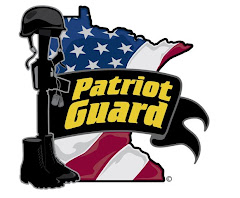MN Patriot Guard Members,
I want to again thank each and every one of you for your dedication to our mission, honoring our fallen military and first responders! During our extreme winter weather, mission attendance drops considerably, so please make that extra effort to attend a mission during this difficult season.
With all the recent political tension, both locally and across the country, I want to send a friendly reminder that we are not a political or anti-protest group. Adhering to this requirement protects our 501c3 status, which allows us to donate tens of thousands of dollars across our state every year helping out our veterans.
Although our MN Patriot Guard patches and gear are purchased and not 'earned', we ask you to leave any reference to the MN PG at home if you participate in any political event, protest, or anything else that may jeopardize our 501c3 status.
I want to again thank each and every one of you for your dedication to our mission, honoring our fallen military and first responders! During our extreme winter weather, mission attendance drops considerably, so please make that extra effort to attend a mission during this difficult season.
With all the recent political tension, both locally and across the country, I want to send a friendly reminder that we are not a political or anti-protest group. Adhering to this requirement protects our 501c3 status, which allows us to donate tens of thousands of dollars across our state every year helping out our veterans.
Although our MN Patriot Guard patches and gear are purchased and not 'earned', we ask you to leave any reference to the MN PG at home if you participate in any political event, protest, or anything else that may jeopardize our 501c3 status.
Our beloved Gold Star families have many beliefs, including political, religious or other that we don't want to offend by appearing to take a stand against. Remember, when you wear your MN PG gear, you are representing the MN PG. If you watched the news over the weekend about happenings in Washington D.C. and the Bikers For Trump, you would've undoubtedly recognized several National Organizations' symbols amongst the anti-protestors. We don't ever want our Gold Star families, whichever way they may lean, to see us involved in such activities. Same goes for state and local events.
Under extreme circumstances, violation of this is grounds for immediate removal from both the MN and National PGR Organization.
If you have any doubt on if wearing your gear is appropriate, it probably isn't, so play it safe and leave your gear at home. And if you're still unsure, ask your Ride Captain, Senior RC, or myself!
Again, thank you for doing the right thing!
Under extreme circumstances, violation of this is grounds for immediate removal from both the MN and National PGR Organization.
If you have any doubt on if wearing your gear is appropriate, it probably isn't, so play it safe and leave your gear at home. And if you're still unsure, ask your Ride Captain, Senior RC, or myself!
Again, thank you for doing the right thing!
** The best we can do is the least we can do. Thank you for doing the right thing. **
Craig Ugland
State Captain - MN Patriot Guard
MN POW/MIA Riders Association
Beyond the Yellow Ribbon SEMN
MN POW/MIA Riders Association
Beyond the Yellow Ribbon SEMN
